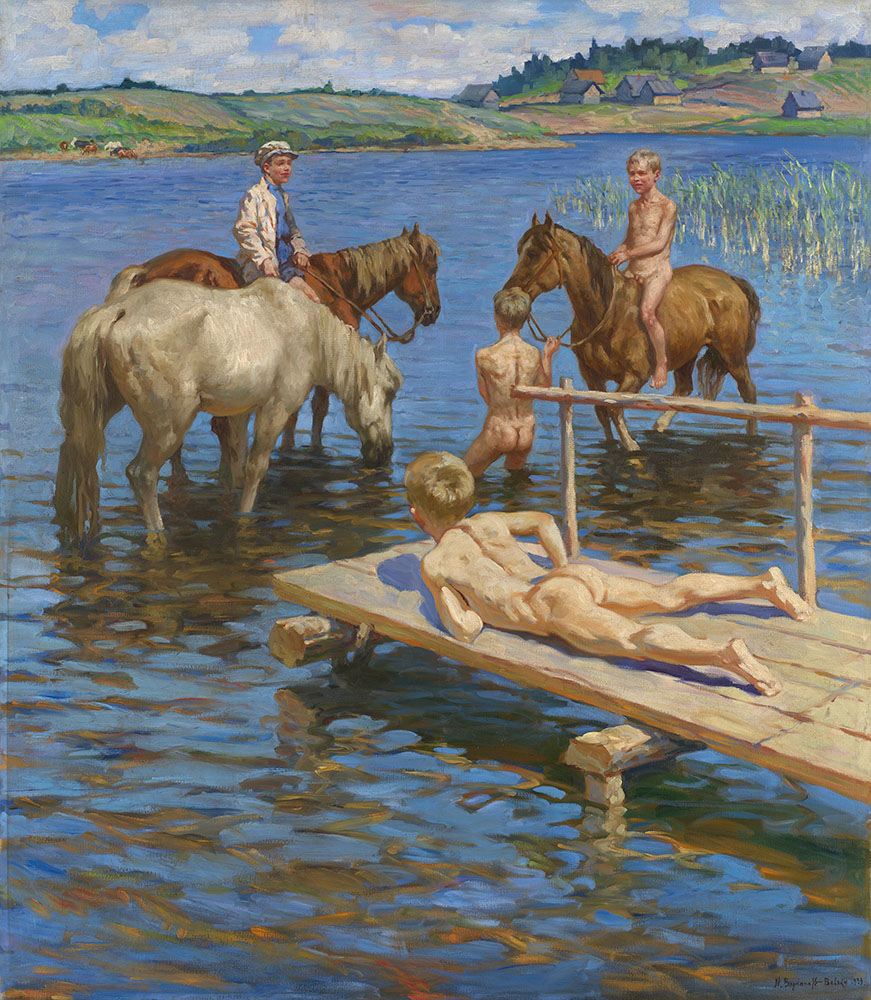MacDougall Auctions 12-18 June 2008
12 June 2008

* 28. BOGDANOV-BELSKY, NIKOLAI 1868-1945
Bathing Horses signed and dated 1939.
Oil on canvas, 143 by 125.5 cm.
170,000-250,000
Authenticity certificate from the State Tretyakov Gallery, expert T. Zelyukina.
The work will be included in the book on Bogdanov-Belsky, prepared by A. Kouznetsoff.
The development of Russian genre painting in the twentieth century is directly associated with the name of Bogdanov-Belsky. A pupil of Pryanishnikov and Makovsky, and later Repin himself, Bodganov-Belsky was to become the heir and torch bearer for the traditions of the Peredvizhniki movement. The artist represented a nexus between old and new Russian art, expanding the boundaries of genre painting, enriching it with his own unique style, and imbuing it with a freedom of composition and colouration. Using Pryanishnikov’s strict system of compositional methods, as well as the directness of Makovsky, Bogdanov-Belsky freed the genre painting from the banal and humble depictions of everyday life, and imparted a dignified serenity and a natural, life-affirming mood to his subjects.
A gifted portraitist and a no less talented landscape artist, Bogdanov-Belsky nevertheless preferred to devote himself wholeheartedly to the traditions of genre painting. Simple Russian children were to become the principal heroes of his works. “I have always been fascinated by the world of childhood, and it is to it that I have devoted, and continued to devote, my entire life. On the one hand there are childhood memories and youthful experiences, and on the other hand there is the almost painful but wonderful childhood world itself ”.
It is notable that Bogdanov-Belsky consciously steered clear of subjects so beloved by the socially aware artists of the Peredvizhniki movement, who depicted joyless, hungry childhood and neglected youth. Bogdanov-Belsky solicitously guarded childhood from the sad and hard humdrum life of simple peasant children, allowing space only for bright, joyful episodes: schooltime, play, rambles in the woods, fishing and bathing.
Bogdanov-Belsky became popular early in his career. His works were much sought after by major collectors of the time like Tsvetkov, Soldatenkov and the brothers Tretyakov, as well as by members of the Tsar’s family. Many of his works were awarded medals at prestigious domestic and foreign exhibitions. The artist earned particular fame by works such as At the School Gate (1887, State Russian Museum, St. Petersburg), Counting Out Loud (1895, The State Tretyakov Gallery, Moscow), A New Story (1891, The National
Museum of History and Culture, Minsk), and Children at the Piano (1918, The State Tretyakov Gallery, Moscow). His style in the Russian period of his creative oeuvre took its final form in the fine de siecle, and had little in common with the characteristically dry style of Pryanishnikov and the rehearsed, traditional style of Makovsky. If one looks closely at the work produced by Bogdanov-Belsky during those years, it does not take long to work out who and what influenced his ever-evolving self-determination. Despite studying at the Parisian studios of Kolarossy and Kormon, Bogdanov-Belsky resisted the oppressive atmosphere of Kormon’s canvases in favour of the object of his admiration, Jules Bastien-Lepage, whose refined sentimental romanticism meant considerably more to Bogdanov-Belsky than all the French academicians and their heroic themes. The lyrical work of Bastien-Lepage with the striking methods employed in his delicate style, and his admiration of rural life, were clearly close to Bogdanov-Belsky’s heart. It was in fact under Bastien-Lepage’s influence that Bogdanov-Belsky created his best works of this period.
In time Bogdanov-Belsky gave up carefully finishing his compositions in earthy colours as it seemed to him that this preliminary tonal selectiveness drained colour from a work and likewise diminished the vividness of a natural light effect, and thus his painting evolved into an impressionist period. By the time he left Soviet Russia in 1921 the colouration of his style had undergone significant change, as had his painting and brushwork technique.
Bathing Horses belongs to the late period of the artist’s work. Inspired by the scenery of Latgalia, and its countless picturesque lakes and forests, Bogdanov-Belsky tirelessly painted landscapes of the area he had fallen in love with, and portraits of the noisy and mischievous local children. The work presented here for sale is part of a large cycle of the artist’s works known as Children of Latgalia. The obvious merits of the painting include its pure, glowing colouration and its faultless composition. The countryside bathed in sunshine, with an azure river and children bathing horses, creates a scene of timelessness and shared experience, and one which is typical of a hot July day and the summer holidays.
Alexander Kouznetsoff.
Notes on symbols:
* Indicates 5% Import Duty Charge applies.
Ω Indicates 20% Import Duty Charge applies.
§ Indicates Artist's Resale Right applies.
† Indicates Standard VAT scheme applies, and the rate of 20% VAT will be charged on both hammer price and premium.